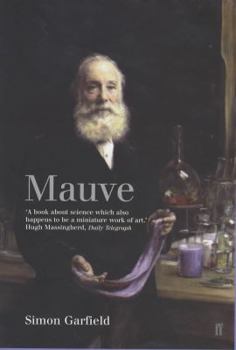Mauve
Select Format
Select Condition 
Book Overview
In 1856 eighteen-year-old English chemist William Perkin accidentally discovered a way to mass-produce color. In a "witty, erudite, and entertaining" (Esquire) style, Simon Garfield explains how the... This description may be from another edition of this product.
Format:Paperback
Language:English
ISBN:0571209173
ISBN13:9780571209170
Release Date:January 2001
Publisher:Faber & Faber
Length:224 Pages
Weight:0.45 lbs.
Age Range:14 to 18 years
Grade Range:Grade 9 to Postsecondary
Customer Reviews
4 ratings
Readers of Jane Austen, lovers of fashion
Published by Thriftbooks.com User , 15 years ago
It is a perfect book for you. It is small, it is great reading,it is entertaining and it will open your mind on the world of inventions behind the color of a dress.
origins of heterocyclic chemistry
Published by Thriftbooks.com User , 21 years ago
This is a fantastic accounting of a too little glorified period in the development of organic chemistry. The story will be inspiring to anyone who has an interest in chemistry and/or business. The latter because the story demonstrates the importance of recognizing and capitalizing on an unexpected invention (vs. more target-oriented discovery).Unlike, most other popular science-related books that this is likely to be lumped with, it is enjoyably written, well researched and full of fascinating facts.
What a Colorful Story!
Published by Thriftbooks.com User , 22 years ago
In 1859 there was a real mania for the color mauve, because it had been invented only three years before. Of course the color had not truly been invented, but people then just started seeing lots of it because the process of dyeing using the color had been invented. The inventor, an Englishman named William Perkin, was someone who achieved a good deal of fame in his time, but is now largely forgotten. _Mauve: How One Man Invented a Color That Changed the World_ (W. W. Norton) by Simon Garfield aims to bring him back to our memories, and in a lucid and enjoyable way, manages just that.Perkin's revolution was to use coal tar derivatives, which had been regarded as useless waste products, to make the first of the aniline dyes; textile dyes before Perkin's day came from "natural sources," and were expensive, unreliable, and subject to fading. Perkin was only eighteen years old when he was tinkering with chemicals, trying to make the antimalarial drug quinine artificially. Perkin was looking for the colorless quinine, but instead produced a reddish powder. It would perhaps have been a sensible decision to scrap what he was working on and try again, but Perkin possessed an admirable curiosity, and further purified the powder to discover the prettiest purple dye anyone had ever seen. Chemists made new colors all the time, so his fellows were horrified that he planned to abandon academic chemistry to go into business, but he decided to go with his entrepreneurial instincts. Garfield describes the grueling duties of the young man trying to make it in a commercial world about which he initially knew little. But mauve took off, becoming the fashionable color, and Perkin's fortune was secure.Perkin was a modest man, whom Garfield obviously admires. When the fiftieth anniversary of mauve came around, he reluctantly accepted a knighthood. It was not for a color, nor for the other colors he invented, nor for the papers he continued to produce for the academic world (usually not about dyes). With the production of the first aniline dye, Garfield demonstrates in his engaging book, it was the start of chemistry anew; the progeny of Perkin's original reactions for fashion now play roles in less superficial arts of medicine, pharmacology, engineering, and more.
Nothing purple about this prose
Published by Thriftbooks.com User , 23 years ago
Simon Garfield has written a fascinating book about the history of something we take utterly for granted, synthetic dyes, how they came about, and how they changed the world of invention. The book focuses on the story of William Perkin, who, as a young man accidentally invents a new kind of dye that does not fade or age the way natural dyes do. From that point on, his challenge is to find a place for his invention in society, and Garfield chronicles admirably the struggles Perkin faced and the impact his struggle had on the field of chemistry, which as a result of this new dye, changes from a field of intellectual scientific research to a field of commercial potential. Garfield's writing is engaging and absorbing, and this is a wonderfully illuminating book.





